Release
Jul. 7, 2016
Engineering Technology Division
JSOL Corporation
The Latest version of J-OCTA v2.1 has been released.
In v2.1, the operability of monomer modeling and molecular system modeling have been improved. Also, the capability to handle multi-scale simulations has been implemented.
Download : J-OCTA User's Site
What's new on J-OCTA v2.1
- High-speed drawing
-
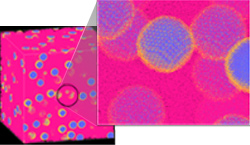 Introduced an interface for drawing large-scale molecular models. By creating 3D drawing data (drawing objects) in advance, models having millions to tens of millions of particles can be drawn quickly without opening the UDF.
Introduced an interface for drawing large-scale molecular models. By creating 3D drawing data (drawing objects) in advance, models having millions to tens of millions of particles can be drawn quickly without opening the UDF.
- Import of CIF format model file
-
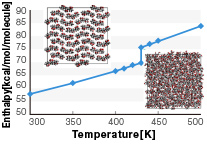 Added support for CIF format model files for easier construction of crystal structures. As an application example, a crystal structure model of sugar alcohol was constructed and molecular dynamics simulations to estimate the melting temperature and the latent heat of the material were conducted.
Added support for CIF format model files for easier construction of crystal structures. As an application example, a crystal structure model of sugar alcohol was constructed and molecular dynamics simulations to estimate the melting temperature and the latent heat of the material were conducted.
- Free volume analysis
-
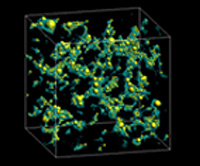 Added support for free volume analysis of polymer bulk systems generated from Full Atomistic Molecular Dynamics calculations. Various sized pseudo particles can be inserted into a free volume to evaluate the distribution of particle sizes.
Added support for free volume analysis of polymer bulk systems generated from Full Atomistic Molecular Dynamics calculations. Various sized pseudo particles can be inserted into a free volume to evaluate the distribution of particle sizes.
- Support for TEAM_MS force fields (a database for material science applications) in Direct Force Field(*1)
- Models associated with TEAM_MS can be calculated by LAMMPS and J-OCTA/VSOP.
(*1) Direct Force Field is software developed by Aeon Technology Inc.
For details, see http://www.aeontechnology.com/
- Added force field parameter (bond, angle, torsion) verification functionality
-
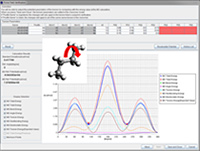 Adjust each force field parameter by comparing the potential energy curves resulting from quantam chemistry calculations (Firefly (PC-GAMESS)/Gaussian) with those acquired from force fields.
Adjust each force field parameter by comparing the potential energy curves resulting from quantam chemistry calculations (Firefly (PC-GAMESS)/Gaussian) with those acquired from force fields.
- Added STL format output for filler dispersion and phase separation calculation
-
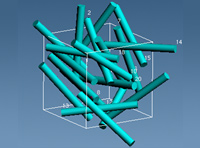 By first representing the model with simple shapes (e.g., sphere, disk, or cylinder), filler models created as Bead-Spring or DPD can now be output in STL format in addition to traditional Digimat ( http://www.e-xstream.com ) format. Also, volume fraction distribution data obtained from SCF calculation etc. can also be output in STL format. The resulting STL file can be read by common FEM software.
By first representing the model with simple shapes (e.g., sphere, disk, or cylinder), filler models created as Bead-Spring or DPD can now be output in STL format in addition to traditional Digimat ( http://www.e-xstream.com ) format. Also, volume fraction distribution data obtained from SCF calculation etc. can also be output in STL format. The resulting STL file can be read by common FEM software.
- Estimation of force field parameters for organic/inorganic interface.
-
 Lennard-Jones parameter adjustment tool has been added in J-OCTA v2.1. Typically, the organic-inorganic interface is considered to be a key factor in controlling the properties of composite materials. Nonbonding interaction parameters such as the Lennard-Jones type potential parameters are required for molecular dynamics simulation of interfacial systems. This adjustment tool provides parameters so that the potential energy curves resulting from quantum mechanical (QM) and force field (FF) calculations will be consistent with each other, to validate parameters. This is an essential tool for researchers in the composite materials field.
Lennard-Jones parameter adjustment tool has been added in J-OCTA v2.1. Typically, the organic-inorganic interface is considered to be a key factor in controlling the properties of composite materials. Nonbonding interaction parameters such as the Lennard-Jones type potential parameters are required for molecular dynamics simulation of interfacial systems. This adjustment tool provides parameters so that the potential energy curves resulting from quantum mechanical (QM) and force field (FF) calculations will be consistent with each other, to validate parameters. This is an essential tool for researchers in the composite materials field.
Download : J-OCTA User's Site
Contact
Engineering Technology Division
JSOL Corporation
E-mail : hg-cae-info@s1.jsol.co.jp
- Product Site : Integrated Simulation System for Soft Mterials J-OCTA





